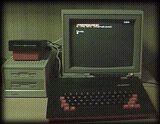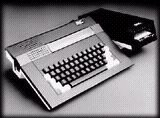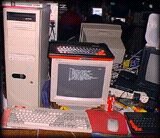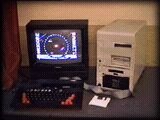Attention: Cet article date de 1998, et fait donc référence à une époque où la scène
oric se limitait à une seule personne... depuis de nombreuses démos sont sorties, Defence
Force est devenu un véritable groupe composé de quatres membres actifs, plus quelques graphistes
auxiliaires. |
Warning: When this article was writen in 1998, the Oric demo scene was composed of exactly
one member... since this time numerous demos have been released, and Defence Force became
a real group with four active members, and some auxiliary artists. |
|
Dbug et moi étions l'un à coté de l'autre lors de la Volcanic 4, j'ai même pris des photos de ses Oric, mais on ne s'est pas parlé alors. C'est sur l'IRC que je l'ai rencontré, et comme j'avais été impressionné par sa démo, je lui ai demandé de me faire un petit topo sur l'Oric. Deux jours après j'avais un énorme article en versions anglaises et française. Voici l'oeuvre d'un passionné.
|
Dbug and me were neigbours at Volcanic Party 4 in France, but we didn't meet. We met on IRC, and as I have been impressed by his demo, I asked him to write an article about the Oric scene. Two days later, I received 2 mails in my mailbox, a french and an english version of a big article. Here is the story of a passionate.
|
La Scene ORIC |
The ORIC Scene |
|
|
Following the official release of the first real Oric demo at the Volcanic 4 demo party, Chandra has asked me to make the presentation of the Oric demoscene as well as a short explanation about how this computer works, its capabilities, to explain you what represents the ORIC world in 1998. |
|
Présentation Mon premier ordinateur à été un Oric Atmos. J'avais déja
|
Presentation My first computer was an Oric Atmos. Before this, I had already used some "ZX81" at the local micro-computer club, but the Atmos was really my first computer... bought with all the money I saved during the past year... At that time, the C64 was priced around 4000fr (USD650), the APPLE II was over 10000fr (USD1630)... And the Oric cost less than 3000fr (USD490), for a color computer with a high resolution graphic mode, sound and a real mechanical keyboard. I was happy ! |
|
J'ai redécouvert l'Oric en 1996, alors que je bossais chez Adeline Software (Little Big Adventure, Time Commando) en tant que programmeur PlayStation. J'ai downloadé l'émulateur, essayé les jeux. La passion est revenu. Après 1 heure sur "Defence Force" (un defender like), je suis revenu sur le net. J'ai découvert le WEB ORIC. Plein de gens encore actifs, un club français (ClubEuropeOric), un club anglais (OricUserMontly), 2 fanzines, des pages completes sur le hardware, des jeux en download, des kits de developement en C et en asm (cross compilation), et des tas de projet en cours (interface IDE, nouvelles versions du DOS, compilateurs Forth et Lisp, nouveaux jeux, etc,...). A ce moment, j'ai décidé de me remettre à coder sur Oric. J'ai commencé un Dungeon Master, et là, je me suis rendu compte que finalement c'était facile de coder avec un Cross-Compiler et un émulateur ! J'ai donc commencé à faire des effets de demo... |
I rediscovered Oric in 1996, while I worked at Adeline Software (Little Big Adventure, Time Commando) as a PlayStation programmer. I downloaded the emulator, replayed the old games. Passion returned. After one hour off "Defence Forces" (a defender look-a-like), I went back to the Net. I discovered the ORIC WEB: Plenty of active people, a French club (Club Europe Oric), an English club (Oric User Montly), 2 fanzines, some pages on the hardware, some downloadable games, development kits for C and asm (cross-compilation), and many projects in progress (IDE interface, new versions of the DOS, Lisp and Forth compilers, new games, etc... ). At this time, I decided to start coding on the Oric again. I began a "Dungeon Master like", and then I realized that finally it was easy to code with a cross-compiler and an emulator! So I started to code demo effects... |
|
La scene ORIC Pour cela, j'avais besoin de doc. J'ai commencé à demander à gauche et à droite. J'ai finalement récupéré des livres de prog 6502 sur Apple 2, le manuel Basic de l'Atmos, des photocopies de la doc constructeur du VIA6522 (le controleur d'interruptions, et I/O). J'ai échangé une boite de "TimeCommando" PC contre un Oric 1, et acheté un Téléstrat (ou Stratos en british) pour 250fr. Je suis parti de mes sources ST pour faire toute le partie sonore. J'ai repris les tables de conversion de mon replay de digit pour jouer des samples avec le YM. Ca marche. Frequence maximale, 8khz, en mono joué sur les 3 caneaux pour une qualité maximale. Il reste 13 nops inutilisés... et le tout en virant les interruptions... Pour le reste, tout est dans la démo présentée à la Wild Compo de la Volcanic 4. Je compte bien continuer, et trouver de nouveaux effets faisables avec le hardware limité de l'Oric ! |
The ORIC Scene For that, I needed documentation.. I started to ask around. I finally recovered books of prog 6502 on APPLE 2, the Atmos BASIC handbook and the manufacturer's documentation of the VIA6522 (the interrupt and I/O controller). I exchanged one box of "Time Commando" PC with an Oric 1, and bought Téléstrat (or Stratos in british) for 250fr. I used my ST 68000 sources to code the whole sound part. I ripped the conversion tables of my digit replay routine to play samples with the YM. It worked fine. Maximum frequency is 8khz mono, played on the 3 channels for maximum quality. There remains 13 unused nops... and the whole thing done with interrupt masking to save processor time... Finally, you can see all I've done in the demonstration presented at the Volcanic 4 Wild Compo. I've great hope in finding new effects feasible with the limited hardware of Oric ! |
|
|
For the moment, the Oric scene, it's me... considering that "Just Oric" is the first demo ever made on this machine. (Except the cassette of demonstration delivered with the machine, that I regarded as the best software ever made for a long time on this machine!). But it will grow bigger! A certain " Twilite " (Jonathan Bristow), English, creates astonishing things with his Oric. He does everything in native mode. He has his Atmos, his 4 disk drives (3 ", 3"1/2, and 5"1/4). With that, Mister Bristow has programmed a soundchip musiceditor, a 3 channel soundtracker... He is really crazy, but he's really good. He masters graphics limitations, as well as video mode switchings. What he does entrances me :) If everything goes right (if I manage to repair my disk controller), the next demonstrations will have original music, and perhaps even soundtrack music. I hope to be able to do 3D, and bitmap effects |
|
Fabrice Françès, auteur d'Euphoric (le meilleur émulateur pour l'instant), a aussi fait des démos sans le savoir. Il a samplé un disque de Patricia kass, et toute la musique est rejouée sur l'oric, à partir du lecteur de disquette. Vu que c'est chargé par morceau, ca donne quelque chose d'amusant du style: "Il me dit que je suis [...] belle !!!! Qu'il [...] nnnn'attendaiiiit que moaaaaaa [...] aaaaa" C'est cool la vie. L'Oric revit, d'ailleurs il y a eu un article de deux pages dans "les Puces Informatiques" n°2 à propos de l'Oric, avec plein de links sur les pages dédiées à cette machine. Récemment, quelqu'un a convertit sur Oric la "Z-machine". Donc, tous les jeux Infocom en mode texte sont sur Oric (Zork, Hitchiker Guide to the Galaxy, ...). |
Fabrice Françès, author of Euphoric (the best emulator so far), has also made demonstrations without being aware he did. He samples a Patricia kass's CD, and all the music is replayed on the oric, loaded from the disk drive. Considering it is loaded block by block, it gives something funny like: " He says to me that I am [...] beautiful!!!! That he [...] was waiting for mee [...] eeeee". Life is cool. Oric has come back to live. We even have a 2 page article the second issue of "les puces informatiques" (a french low cost magazine) talking about Oric. Recently, someone started porting the " Z-machine " for the Oric. Thus, all the Infocom games in text mode are playable on the Oric (Zork, Hitchiker Guide to the Galaxy...). |
|
Description technique de l'Oric (1, ou Atmos) Le processeur: |
Technical description (Oric 1 or Atmos) The processor: |
|
La mémoire: |
The memory: |
|
La vidéo: |
The video: |
|
Le son: |
The sound: |
|
En gros, pensez que l'Oric, c'est comme un C64 qui aurait les capacités graphiques d'un ZX Spectrum (en plus mauvais). Puissant non ? |
In summary, and I will finish here, you can view the Oric as a C64 with the graphics ability of a ZX spectrum (in worse). Powerful, isn't it ??? |

|
|
| Maintenant que vous en savez plus sur la machine, allez donc jeter un coup d'oeuil dans la section Oric , et téléchargez les démos. | Now, since you know a lot more about this machine, go to the Oric section of this site, and download the demos. |






